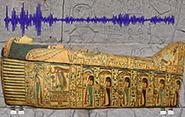Protecting History: Students Collaborate with Met Museum Staff

Vibrations in the museum environment can be risky for artwork, particularly when that artwork is thousands of years old. Recently, students from Introduction to Engineering, Innovation, and Design (ENAS 118) had the opportunity to collaborate with conservators, curators and scientists from The Metropolitan Museum of Art to help devise a vibration-dampening solution for ancient wooden coffins in the Egyptian Art collection.
In that class, taught at the Center for Engineering Innovation & Design (CEID), students break off into teams, each taking on a different project proposed to them by “clients.” Other projects this year included a moving light sculpture for the Center for Collaborative Arts & Media and four projects for the athletics department - a football tackling dummy, a practice device for lacrosse players, a device to measure angles for the crew team, and camera technology to assist in sailing practice.
For the collaboration with the Met, Anna Serotta, the associate conservator responsible for the museum’s Egyptian Art collection, outlined the problem to the students: Vibration of any kind—from construction or set-up for special events or from music played during concerts—has the potential to cause damage to the fragile artifacts held in the adjacent space.
Building on previous studies carried out by Met staff with engineers from Columbia University, the student team of Maria Bambrick-Santoyo, Kaitlyn Sandor, Joe Murphy and Connor Mann took on the challenge of dampening vibration. With some direction from teachers Larry Wilen, CEID senior research scientist, and SEAS Deputy Dean Vincent Wilczynski, the four first-year students worked in the CEID’s Klingenstein Lab to build a scaled-down mock pedestal and coffin. From there, they devised a solution that involves a finely calibrated system of springs and polyethylene foam. The springs absorb the vibrations, while the foam prevents the springs from moving and disturbing the coffin.
Being the only team in the class working with an off-campus collaborator was a little tricky, but through Skype and emails, the student team and the folks at The Met developed a good work flow. By semester’s end, the team came up with a solution that impressed all involved. It requires further testing and implementation, but staff at the Met find the idea very promising. Wilen notes that the coffin-and-pedestal model can easily be scaled up to the originals at the Met, and further modified for testing on other items.
Before they began work on the project, the entire class took a trip to New York to see the Egyptian art galleries in person. The students said they were surprised that one of their first engineering projects would involve millennia-old artifacts invaluable to history.
“I come from Milwaukee, Wisconsin, and I’d never been to New York, so when I went, I was awestruck by the prestige of working with such a great and wonderful institution,” Murphy said.

